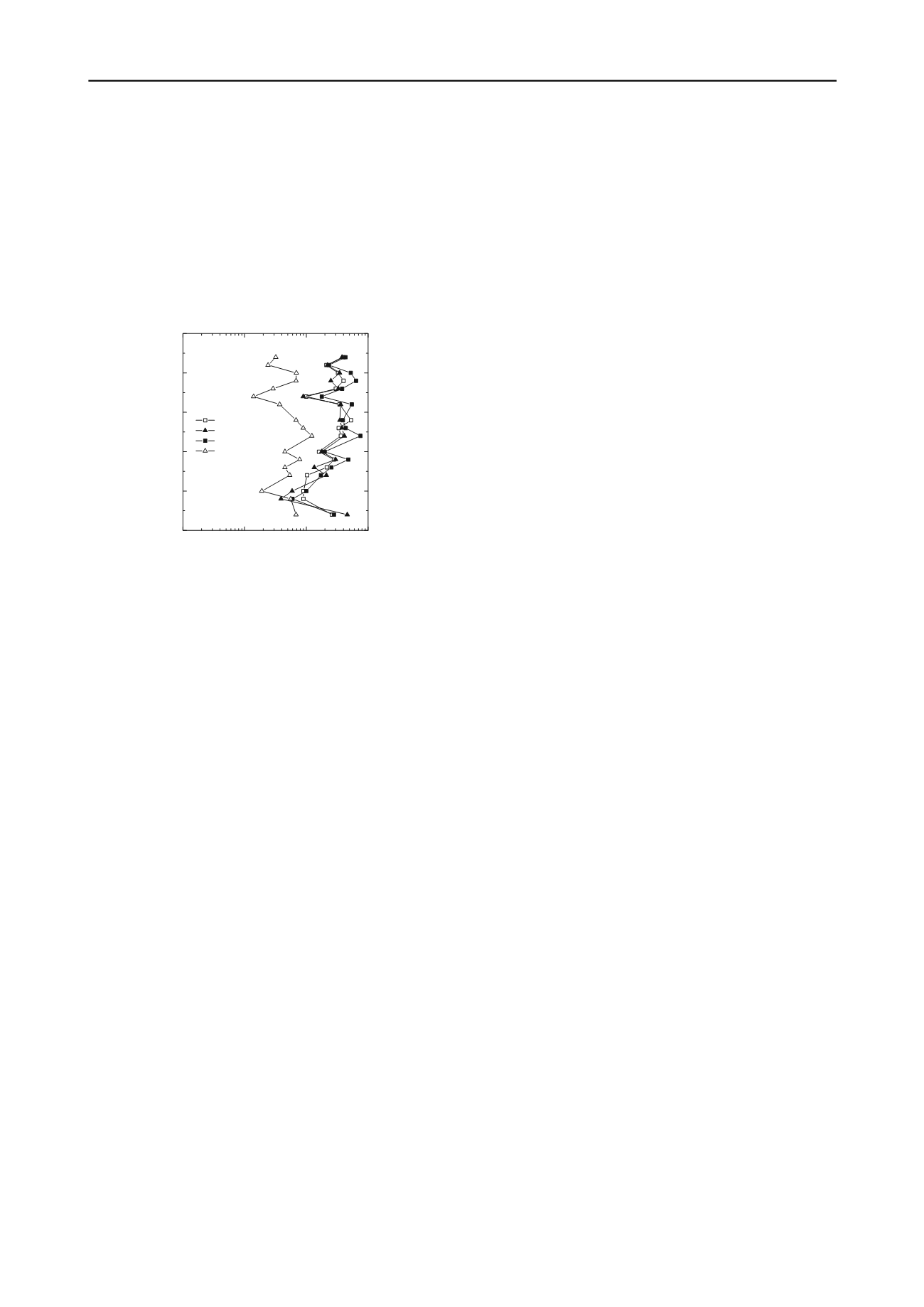
578
Proceedings of the 18
th
International Conference on Soil Mechanics and Geotechnical Engineering, Paris 2013
The
k
v
values measured by oedometer test and
k
h
values
deduced from CPTu test are compared with each other in Figure
6. The values of coefficient of permeability from back-analysis
and falling-head permeability tests are also presented in Figure
6. The comparison shows that the
k
h
values measured by
oedometer are lower than those obtained from CPTu test within
1-2 order of magnitude. The coefficient of permeability of
Taihu lacustrine clay is in the order of 10
-5
-10
-7
cm/s. The
k
h
value measured by falling-head permeability tests agrees well
with that determined by CPTu tests.
6 REFERENCES
Abu-Farsakh, M.Y. & Nazzal, M.D. 2005. Reliability of piezocone
penetration test methods for estimating the coefficient of
consolidation of cohesive soils
.
Journal of the Transportation
Research Board
. No. 1913, 62-76.
Baligh, M. M. & Levedoax, J. N. 1980. Pore pressure dissipation after
cone penetration
. PhD Thesis
, Massachusetts Institute of
Technology. Cambridge, Mass, 80-111.
Cai, G., Liu, S., Tong, L., 2010. Field evaluation of deformation
characteristics of a lacustrine clay deposit using seismic piezocone
tests
. Engineering Geology,
116(3-4), 251-260.
25
20
15
10
5
0
1E-8
1E-7
1E-6
1E-5
k h (cm/s)
Depth (m)
CPTU
Falling-head tests
Asaoka back-analysis
Oedometer
Danziger, F.A.B., Almeida, M.S.S. & Sills, G.C. 1997. The significance
of the strain path analysis in the interpretation of piezocone
dissipation data.
Geotechnique
, 47(5): 901-914.
Jamiolkowski, M., Ladd, C.C., Germaine, J.T., and Lancellotta, R.
1985. New developments in the field and laboratory testing of soils
:
State of the art.
Proceedings of the 11th International Conference
on Soil Mechanics and Foundation Engineering
, San Francisco, 12-
16 August 1985. A.A. Balkema, Rotterdam. Vol. 1, pp. 57-153.
Kulhawy, F.H., and Mayne, P.W. 1990. Manual on estimating soil
properties for foundation design
.
Report No. EL-68000, Electric
Power Research Institute, EPRI,
August 1990. Palo Alto. 306 pp.
Liu, S. Y. and Wu, Y. K. 2004. On the state-of-art and development of
CPT in China.
Chinese Journal of Geotechnical Engineering
, 26(4),
553-556.
Liu, S. Y. Cai, G. J. Tong, L. Y. Du, G. Y. 2007. On preconsolidation
pressure of clays from piezocone tests.
Chinese Journal of
Geotechnical Engineering,
29(4): 490-495.
Figure 6. Comparison of k
h
profiles measured by different methods
4 CONCLUSIONS
The comparison of various cone sizes and configurations
between China CPT and international standard CPTu device at
28 field testing sites is presented. The relationships of derived
key parameters are developed between China CPT and
international CPTu. From the perspective of engineering
practice, it is concluded that
q
t
= 1.03
q
c
,
f
s-CPTU
= 1.05
f
s-CPT
.
The empirical equation can be used as useful engineering tool to
guide use of 10 cm
2
international CPTu in China. The field
CPTu tests were carried out in Jiangsu sites to evaluate the
stress history. Consequently, we obtained the value of
N
σt
factor, which is equal to 2.7 according to the correlation
relationship for Lianyungang lightly overconsolidated clay. The
results show that ratio of
M
derived from Kulhawy and Mayne
1990’s method to that determined from laboratory oedometric
tests,
M
-CPTU
/
M
-lab
, practically equals to 2.21 for high plasticity
clays. A quick estimation of the magnitude of coefficient of
consolidation c
h
is proposed by pore pressure dissipation (type
u
2
) tests from the CPTu database. Comparisons of the results
obtained by different methods indicate that the values of
horizontal coefficient of consolidation determined by CPTu are
typically 4 to 6 times those of laboratory tests. The coefficient
of permeability values measured by laboratory tests are less
than by almost 1-2 orders of magnitude with that determined by
CPTu tests in Jiangsu soft clays.
Lunne, T., Robertson, P.K., Powell, J.J.M., 1997. Cone penetration
testing in geotechnical practice,
Blackie Academic & Professional,
Chapman & Hall
, London.
Mayne, P.W. 1991. Determination of OCR in clays by piezocone tests
using cavity expansion and critical state concepts.
Soils and
Foundations
, 31(2): 65-76.
Powell, J. J. M. and Lunne, T. 2005. A comparison of different sized
piezocones in UK clay.
Proceedings of the 16th International
Conference on Soil Mechanics and Geotechnical Engineering
,
Osaka, 729-734.
Robertson, P.K., Sully, J.P., Woeller, D.J. et. al. 1992. Estimating
coefficient of consolidation from piezocone tests.
Canadian
Geotechnical Journal,
29(4):539-550.
Schnaid, F., Sills, G.C., Soares, J.M. & Nyirenda, Z. 1996. Predictions
of the coefficient of consolidation from piezocone tests.
Canadian
Geotechnical Journal
, 34, No. 2, 315-327.
Teh, C.I. 1987. An analytical study of the cone penetration test.
PhD
Thesis
, Dept. of Civil Engineering, Oxford university.
Teh, C.I. & Houlsby, G.T. 1991. An analytical study of the cone
penetration test in clay.
Geotechnique
, 41(1): 17-34.
5 ACKNOWLEDGEMENTS
The work in this paper was funded by the National Natural Scie
nce Foundation (Grant No. 41202203) of China,“Twelfth five-y
ear” National Science and Technology Support Plan (Project No
. 2012BAJ01 B02) and the Key Project of Natural Science Foun
dation (Grant No. BK2010060) of Jiangsu Province of China.


